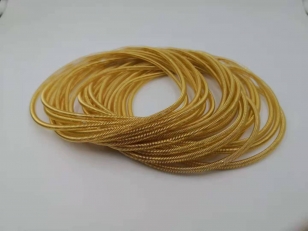There are several elastic elements with crests and troughs on the metal ring, while the multilayer spring appears to consist of many single-layer springs and cylindrical snails. Rotating springs are similar. Wave springs are widely used in the main installation and specifications of electric motors, textile machinery, machinery manufacturing, petrochemical, hydraulic equipment, automobiles and other industries. (nominal size) in a suitable bearing chamber or bore, with little installation space, with special noise and vibration reduction functions. Suitable for large and small strokes. The timing of the loading. Compared to ordinary coil compression springs, at least half the space can be saved under similar loads, and the overall volume and cross-section of the equipment can be reduced. The cost is close; Ideal for places where axial space is limited; It can be manufactured by changing the thickness and width of the material or by making two or three overlapping wave springs. Meet the requirements of different loads.

The manufacturing process of disc spring washer is: (1) unloading, punching out of the butterfly shape; (2) heat treatment; (3) Countertops. Noodle processing. Next, we will focus on the surface treatment of disc spring washers. Disc spring washers are blue, also known as blackening, a material protection technology that heats steel in air or immerses it directly in a concentrate. In the oxidizing solution, a very thin oxide film is created on the surface of the saucer. The electrophoresis treatment of disc spring washers is to treat the surface of the disc spring washer to remove obstacles on the film surface and coating. Eliminate factors that affect the combination of impurities such as oil, rust spots, and scaling. Disc spring washer phosphating, usually used for the surface treatment of carbon steel coil spring scrubbers, has a good finish, can be treated with phosphoric acid or phosphoric acid. The salt reacts to form a stable phosphating film on the surface of the disc spring. The disc spring washer is electroplated by electrolysis process, and metal or alloy is deposited on the surface of the coil spring washer to form a metal plating table. surface treatment technology; Disc spring washers are usually plated: zinc plating, nickel plating, etc. Mechanical disc spring washers form metal powder on the surface of coil springs through physical, chemical adsorption deposition and mechanical collision at room temperature and pressure. This process. Ordinary disc gaskets are mechanically galvanized. A disc spring is a special spring that is tapered in the axial direction and carries the load. After bearing the load and deformation, a certain potential energy is saved under the action of the bolt. When relaxation occurs, the disc spring releases part of the potential energy to keep the pressure between the flange connections meeting the sealing requirements. The stress distribution of disc springs is uniform from the inside out. The descent is uniform, and the effect of low stroke and high compensation force can be achieved. Disc springs, also known as disc spring washers, were invented by the French disc spring company. It is conical and disc-shaped and can be used alone. It can also be used in series or parallel, bearing static and dynamic loads along the axial direction of the upper inner and lower outer edges, and deformation occurs after compression. Until it is flattened and used as a living load in the form of stored energy. If necessary, it is automatically converted into sealing to reduce the additional compressive loads required for gaskets, continuous tightening requirements during the use of the filler. Disc springs can be divided into three categories according to thickness: the first type is T<1.25mm, the second type is 1.25mm≤T≤6mm, the third type is 6mm≤T≤14mm, the thickness is different.
The manufacturing process of disc springs is different, the situation is as follows: di a kind of disc spring: stamping forming "quenching" tempering "polishing" strong pressure treatment "surface treatment" inspection. The second type of disc spring: punching ring blank "grinding both sides" car inner and outer diameters and inverted round "conical cold forming" high temperature normalizing "heat treatment" shot peening "high pressure" surface. Administering exams. The third type of disc spring: round steel blanking "forged cone" turned to the required size "high temperature normalizing", "quenching", "tempering", "shot peening strengthening" "strong surface treatment" inspection. DI Class I disc spring stamping does not need to reserve a machining allowance, and Type II and III disc spring blanks generally need to reserve -4mm machining allowance. In addition, disc springs should be formed in the mold to ensure the accuracy requirements such as concentroid circles inside and outside. Shot peening is done to increase the fatigue of disc springs. High strength, high pressure treatment reduces creep effects and increases the service life of disc springs, and surface treatment prevents disc springs from failing due to corrosion! Disc spring is a kind of high temperature resistant disc spring, suitable for high temperature working environment, with excellent anti-corrosion performance. Main uses. Equipment operating in high-temperature environments, such as high-temperature valves, can also be used for pipe bolt connection preload and anchor bolt preload. Widely used in power plants and petrochemical plants. Pipe flanges, valves, heat exchangers, electric furnaces and other equipment in high temperature environment of steel mills. As an indispensable and important part of modern industrial production, butterfly springs play a pivotal role in modern industrial production, and the reason why butterfly springs can be applied in modern industrial production is because butterfly springs play an important role in modern industrial production. One of the reasons why so many industries play an important role is that it has advantages and advantages that other products do not have.
That. Let's briefly talk about what advantages it has. First of all, butterfly springs have good wear resistance and longer service life. I have to say, because of the production. The material is more delicate, and it is repeatedly tested during production and processing, and even in the production and processing process, it can better ensure wear resistance. For a long time, its appearance will not be affected in any way. Second, butterfly springs have good high temperature resistance and strong environmental adaptability.













